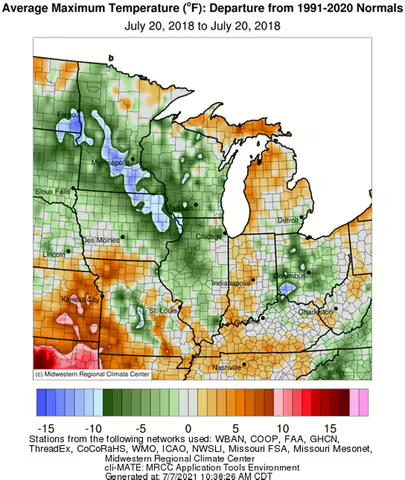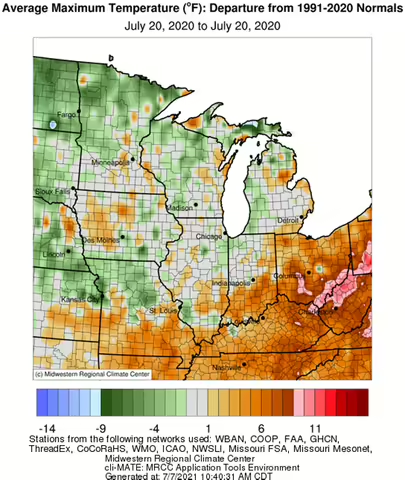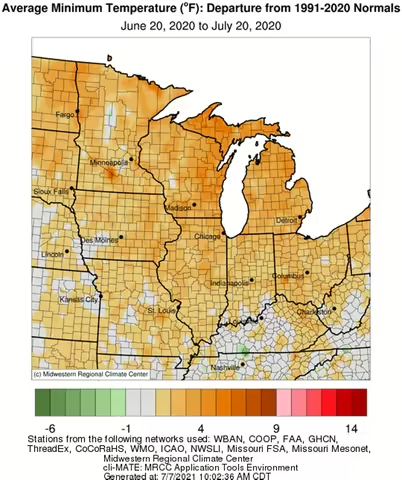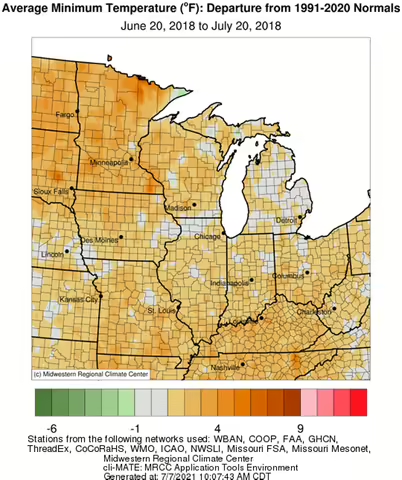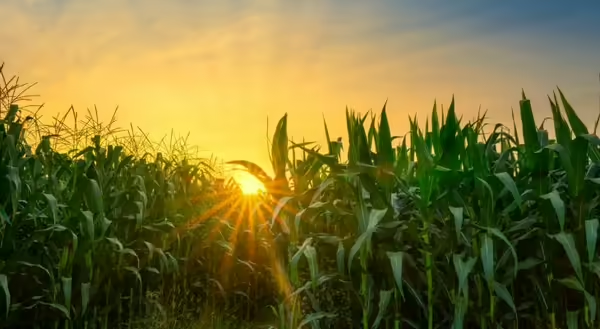
As I write this article, corn has tasseled on about 80% of fields in Central Illinois. Apologies to those with corn pollen allergies!
Corn, just like other plants, experiences evapotranspiration (ET). Evapotranspiration is when water is taken up by corn plants, water vapor - the gas form of water - is released into the atmosphere from the leaves while evaporation occurs from the soil, which also adds water vapor to the air.
During the height of corn growth, a huge amount of water vapor is released into the atmosphere.
What is “corn sweat”?
Have you ever heard of “corn sweats”? This term relates to the high humidity created from the evapotranspiration from corn. At its peak, corn can add up to 4,000 gallons of water vapor to the atmosphere per acre per day.
For reference, there’s a little under 93 million acres of corn planted in the United States in 2021. This added moisture raises humidity levels, which has several effects on weather.
How does corn evapotranspiration affect weather?
One of the effects, as you might have guessed, is the added moisture in the air makes it muggy outside.
- Increased heat index: More water vapor in the air decreases evaporation off our skin, which in turn can increase chances of heat exhaustion, etc.
- Moderator of temperature: Higher humidity decreases the chances for extreme high actual temperatures, but the “feels like” temperatures may be quite high.
These maps show the departure from average high temperatures for the peak growth period of most corn in 2018 and 2020.
At night, there’s not as much of a dip in temperature. Opening the windows at night doesn’t work well because all you’re letting in is still warm, wet air.
These two maps show the departure from average minimum temperatures.
Evapotranspiration Corn vs. Prairie
Now you may be thinking, how does this evapotranspiration compare to natural vegetation, or in other words, prairie?
Recent studies showed the amount of evapotranspiration between cornfields and prairie habitats are fairly similar in eastern areas of the corn belt, but corn may have much higher evapotranspiration in dryer areas such as the Great Plains.
The timing of peak evapotranspiration is also different. Prairie hits its evapotranspiration peak earlier in the season compared to corn. That may mean summer mugginess was not as great when prairie covered the landscape, but that is just speculation on my part.
Does the higher atmospheric moisture from corn during the summer increase chances for precipitation?
One study says yes. According to an article in Geophysical Research Letters, results of both regional climate model simulations and observational analyses suggest that much of the observed rainfall increase — as well as the decrease in temperature and increase in humidity — is attributable to agricultural intensification in the central United States.
What does it all mean?
To sum it up, corn affects our weather by:
- Decreasing chances for extreme high actual temperatures during the day
- Increasing the “feels like” temperatures
- Increasing chances for higher nighttime temperatures
- Increasing chances for more rain
- Making the air feel more tropical
Some are good, some are uncomfortable. But those of us who have lived in the Midwest most or all of our lives expect this, don’t we? It makes late summer and early fall feel glorious!
References:
- Midwest Regional Climate Center mrcc.illinois.edu/CLIMATE
- Baeumler, N.W., J. Kjaersgaard, and S.C. Gupta. 2019. Evapotranspiration from corn, soybean, and prairie grasses using the METRIC model. Agron. J. 111.
- Ross E. Alter, Hunter C. Douglas, Jonathan M. Winter, Elfatih A. B. Eltahir Twentieth Century Regional Climate Change During the Summer in the Central United States Attributed to Agricultural Intensification doi.org/10.1002/2017GL075604
Never miss a new post! Sign up for our email list.
MEET THE AUTHOR Duane Friend is an energy and environmental stewardship educator with University of Illinois Extension, serving the organization in many roles since 1993. Duane provides information and educational programs to adult and youth audiences in the areas of soil quality, weather and climate, energy conservation, and disaster preparedness. These programs provide practical solutions for families, farms, and communities. He assists families in creating a household emergency plan, farmers with the implementation of soil management and conservation practices, and local government officials and business owners with energy conservation techniques.
ABOUT THE BLOG All About Weather is a blog that explores the environment, climate, and weather topics for Illinois. Get in-depth information about things your weather app doesn't cover from summer droughts to shifting weather patterns.
